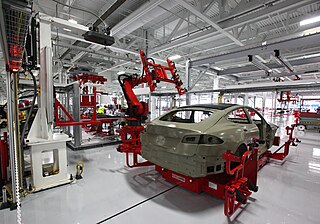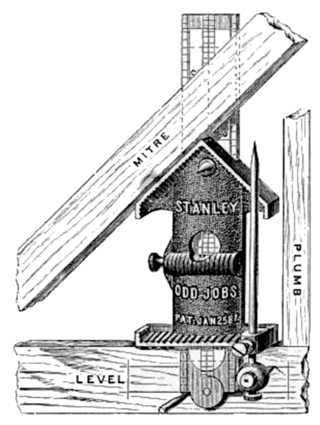Related Research Articles

An alloy is a mixture of chemical elements of which at least one is a metal. Unlike chemical compounds with metallic bases, an alloy will retain all the properties of a metal in the resulting material, such as electrical conductivity, ductility, opacity, and luster, but may have properties that differ from those of the pure metals, such as increased strength or hardness. In some cases, an alloy may reduce the overall cost of the material while preserving important properties. In other cases, the mixture imparts synergistic properties to the constituent metal elements such as corrosion resistance or mechanical strength.

Steel is an alloy of iron and carbon with improved strength and fracture resistance compared to other forms of iron. Because of its high tensile strength and low cost, steel is one of the most commonly manufactured materials in the world. Steel is used in buildings, as concrete reinforcing rods, in bridges, infrastructure, tools, ships, trains, cars, bicycles, machines, electrical appliances, furniture, and weapons.

Manufacturing is the creation or production of goods with the help of equipment, labor, machines, tools, and chemical or biological processing or formulation. It is the essence of the secondary sector of the economy. The term may refer to a range of human activity, from handicraft to high-tech, but it is most commonly applied to industrial design, in which raw materials from the primary sector are transformed into finished goods on a large scale. Such goods may be sold to other manufacturers for the production of other more complex products, or distributed via the tertiary industry to end users and consumers.

Wrought iron is an iron alloy with a very low carbon content in contrast to that of cast iron. It is a semi-fused mass of iron with fibrous slag inclusions, which give it a wood-like "grain" that is visible when it is etched, rusted, or bent to failure. Wrought iron is tough, malleable, ductile, corrosion resistant, and easily forge welded, but is more difficult to weld electrically.

Cast iron is a class of iron–carbon alloys with a carbon content of more than 2% and silicon content around 1–3%. Its usefulness derives from its relatively low melting temperature. The alloying elements determine the form in which its carbon appears: white cast iron has its carbon combined into an iron carbide named cementite, which is very hard, but brittle, as it allows cracks to pass straight through; grey cast iron has graphite flakes which deflect a passing crack and initiate countless new cracks as the material breaks, and ductile cast iron has spherical graphite "nodules" which stop the crack from further progressing.

A blacksmith is a metalsmith who creates objects primarily from wrought iron or steel, but sometimes from other metals, by forging the metal, using tools to hammer, bend, and cut. Blacksmiths produce objects such as gates, grilles, railings, light fixtures, furniture, sculpture, tools, agricultural implements, decorative and religious items, cooking utensils, and weapons. There was an historical distinction between the heavy work of the blacksmith and the more delicate operation of a whitesmith, who usually worked in gold, silver, pewter, or the finishing steps of fine steel. The place where a blacksmith works is called variously a smithy, a forge or a blacksmith's shop.

A machine tool is a machine for handling or machining metal or other rigid materials, usually by cutting, boring, grinding, shearing, or other forms of deformations. Machine tools employ some sort of tool that does the cutting or shaping. All machine tools have some means of constraining the workpiece and provide a guided movement of the parts of the machine. Thus, the relative movement between the workpiece and the cutting tool is controlled or constrained by the machine to at least some extent, rather than being entirely "offhand" or "freehand". It is a power-driven metal cutting machine which assists in managing the needed relative motion between cutting tool and the job that changes the size and shape of the job material.

Metalworking is the process of shaping and reshaping metals in order to create useful objects, parts, assemblies, and large scale structures. As a term, it covers a wide and diverse range of processes, skills, and tools for producing objects on every scale: from huge ships, buildings, and bridges, down to precise engine parts and delicate jewelry.

A hand plane is a tool for shaping wood using muscle power to force the cutting blade over the wood surface. Some rotary power planers are motorized power tools used for the same types of larger tasks, but are unsuitable for fine-scale planing, where a miniature hand plane is used.

Carbon steel is a steel with carbon content from about 0.05 up to 2.1 percent by weight. The definition of carbon steel from the American Iron and Steel Institute (AISI) states:
Frederick Trent Stanley was an American industrialist born in New Britain, Connecticut.

Malleable iron is cast as white iron, the structure being a metastable carbide in a pearlitic matrix. Through an annealing heat treatment, the brittle structure as first cast is transformed into the malleable form. Carbon agglomerates into small roughly spherical aggregates of graphite, leaving a matrix of ferrite or pearlite according to the exact heat treatment used.

MTD Products is an American manufacturer of outdoor power equipment for the mass market. Headquartered in Valley City, Ohio, the company began in 1932 and is a wholly-owned subsidiary of Stanley Black & Decker. Prior to Stanley Black & Decker's acquisition in December 2021, MTD Products was a majority family-owned, private company. It originated as a tool and die maker. MTD's main competitors are Stihl, Ariens, Briggs & Stratton, John Deere and Husqvarna.
Bedrock is a design of bench planes developed by Stanley Works as an attempt to improve over the Bailey plane design. It was introduced in the early 20th century.
Foundry Products Operations was a subsidiary operation of the Cincinnati Milling Machine Company (CMM), a company which no longer exists. Some parts of the company evolved into the present Milacron, Inc. and Cincinnati Machine. CMM relied heavily on castings for the manufacturing of its machine tool products. The castings were produced at Cincinnati foundries owned by CMM and at foundries independent of CMM, between 1907 and 1988.

The Stanley No. 1 Odd Jobs was a tool produced by the Stanley Works from 1888 to the 1930s. It combined features of sundry tools, in a single pocketable tool, including:
Channellock is an American company that produces hand tools. It is best known for its pliers—the company manufactures more than 75 types and sizes of pliers—particularly its eponymous style of tongue-and-groove, slip-joint pliers. Its pliers have distinctive sky-blue handle grips; the company has been using the same trademarked shade of blue since 1956.

American Cast Iron Pipe Company is a manufacturer of ductile iron pipe, spiral-welded steel pipe, fire hydrants, and valves for the waterworks industry, and electric-resistance-welded steel pipe for the oil and natural gas industry. Headquartered in Birmingham, Alabama, American's diversified product line also includes static castings and high performance fire pumps.

Bremen Castings, Inc (BCI) is a 4th generation family owned manufacturer of machined complete gray & ductile iron castings for heavy truck, valves & pipe fittings, pump components, compressors, lawn/garden equipment, and military contract work. BCI is headquartered in Bremen, Indiana.
Garrett Wade is a family-owned business, established in 1975 and based in DUMBO, Brooklyn and Cincinnati, Ohio. It sources and sells a range of high quality hand tools, primarily for woodworking, gardening, and outdoor work, based on traditional designs. It is best known for its tools used for woodworking. Garry Chinn is the founder and CEO of Garrett Wade.
References
- ↑ Garrett Hack and John S. Sheldon. The Handplane Book. Taunton Press: Newtown, CT. 2003. 236-239 ISBN 1561587125
- ↑ Lie-Nielsen's FAQ page
- 1 2 3 4 Furniture & Cabinetmaking issue 63, Lie-Nielsen Feature.
- ↑ Quote from Gerry Chinn in the F&C feature